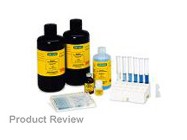
The Bio-Rad DC (detergent compatible) assay is a colorimetric method for measuring protein concentrations. Bio-Rad modified the widely used Lowry method (Lowry et al., J. Biol. Chem. 193: 265-275 (1951)) to reduced assay time, increase compatibility with detergents and provide higher stability of the colorimetric complex. The Lowry assay is based on the formation of a complex between copper and peptide bonds under alkaline conditions, reducing copper to a monovalent copper ion. The ion then reacts with the radical groups of tyrosine, tryptophan, and cysteine with the yellow Folin reagent to form an unstable product that when reduced, develops a molybdenum/tungsten blue color.
The Bio-Rad DC Assay Kit contains 250 ml alkaline copper tartrate solution (solution A), 2 ml dilute Folin reagent (solution B), 5 ml surfactant solution (solution S) and either bovine gamma-globulin standard (Kit I) or bovine serum albumin standard (Kit II). These reagents can also be purchased individually. The kit contains enough reagents for 500 (standard) or 10,000 (microtiter plate) assays with high protein concentration or 2,500 (standard) or 25,000 (microtiter plate) assays with low protein concentration. Note: samples with high protein concentrations (0.2-1.5 mg protein/ml) and low concentrations (5-250 µg protein/ml) can be assayed in either a standard test tube or microtiter plate, depending on the volume. The assay is compatible with most buffers, detergents (even in higher concentrations) and when performing a standard assay, with some reducing agents (DTT, guanidine HCl.). In order to test the interference of reagents in combination and/or a new unknown reagent, it is recommended that the standard curve be established using the same buffer as the samples. The DC assay can be performed at room temperature. Measurement of the protein concentration is carried out after 15 min to 1h at 650-750 nm in a spectrophotometer or microtiter plate reader.
I have routinely used the Bio-Rad DC Kits (in different labs) to measure protein concentrations with either bovine serum albumin or immunoglobulin as a standard. Since some of my tissues had to be homogenized in 1% NP40 for solubilization and also contained limited amount of protein, I used the kit assay with microplates. I also used the kit for measuring protein concentrations of a purified recombinant protein in urea-containing buffer before analyzing it on a gel. Since both of my samples contained reagents that are compatible with this assay, but could change the protein measurement, I prepared 4-5 standard solutions with different protein concentrations in the same buffer in which I homogenized the samples. With these samples I either used the assay for the low (tissue) or high (recombinant protein) concentration of protein. For the detergent-containing sample, I added Solution S to reagent A before mixing the solution with the samples. Solution B was then added to each sample and immediately mixed by pipetting several times up and down. I once received a precipitated Solution S in a new kit, which did not clear even after heating to 37°C; Bio-Rad technical service immediately sent me a replacement bottle.
I have used the standard assay with cell lysates or isolated cell membrane preparations in buffer. The standard assay format allows for easy and quick mixing by vortexing after adding the reagents, but it was inconvenient to handle larger volumes and then transfer part of the reaction to a cuvette for measuring the protein concentration in a spectrophotometer. Therefore, I liked the microplate assay better as it was easy to prepare even with several samples in duplicate. It is also much more sensitive (which helped me to reduce the volumes I needed to measure protein from precious samples) and easy to measure by just placing the plate in a microplate reader.
For measuring a variety of protein solutions and homogenates, I highly recommend the DC Assay Kits. They are very versatile with the different assay sizes and allow the usage of small volumes to save precious samples as well as measure small amounts of protein with the microplate assay. The assay protocol is easy to follow and the assay fast and reliable.